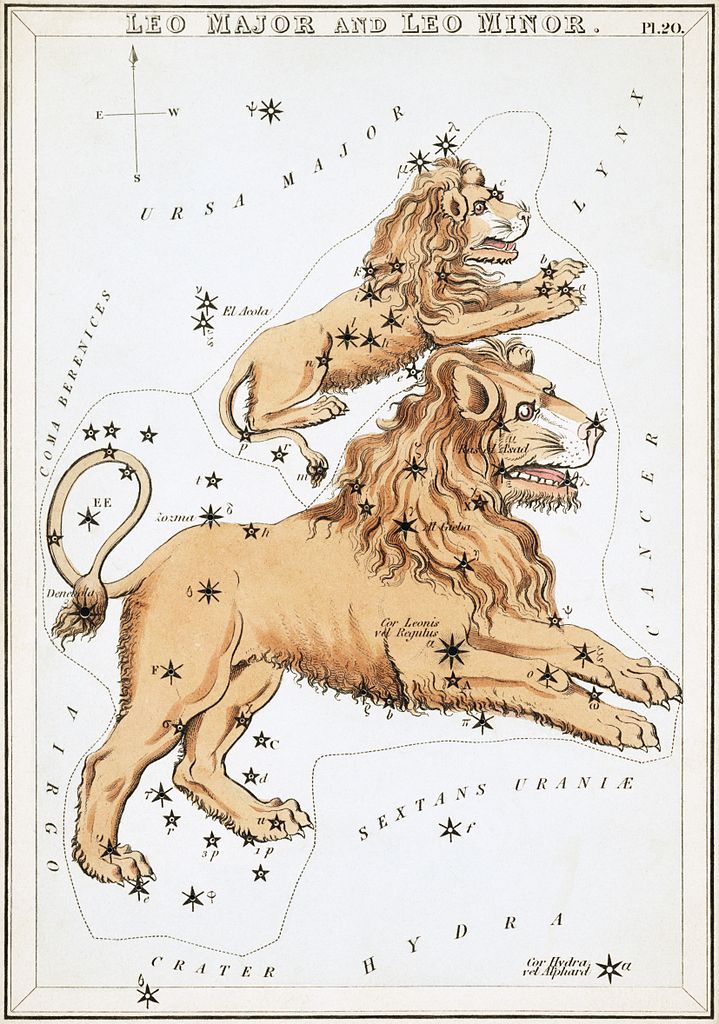others at the Silver Lion;
Original French: les aultres au Lion d’argent:
Modern French: les aultres au Lion d’argent:
Leo
Leo
Leo is one of the constellations of the zodiac, lying between Cancer to the west and Virgo to the east. Its name is Latin for lion, and to the ancient Greeks represented the Nemean Lion killed by the mythical Greek hero Heracles (known to the ancient Romans as Hercules) as one of his twelve labors. Its symbol is (♌). One of the 48 constellations described by the 2nd century astronomer Ptolemy.
Leo was one of the earliest recognized constellations, with archaeological evidence that the Mesopotamians had a similar constellation as early as 4000 BCE.[9] The Persians called Leo Ser or Shir; the Turks, Artan; the Syrians, Aryo; the Jews, Arye; the Indians, Simha, all meaning “lion”.
Some mythologists believe that in Sumeria, Leo represented the monster Humbaba, who was killed by Gilgamesh.[10]
In Babylonian astronomy, the constellation was called UR.GU.LA, the “Great Lion”; the bright star Regulus was known as “the star that stands at the Lion’s breast.” Regulus also had distinctly regal associations, as it was known as the King Star.[11]
In Greek mythology, Leo was identified as the Nemean Lion which was killed by Heracles (Hercules to the Romans) during the first of his twelve labours.[9][7] The Nemean Lion would take women as hostages to its lair in a cave, luring warriors from nearby towns to save the damsel in distress, to their misfortune.[12] The Lion was impervious to any weaponry; thus, the warriors’ clubs, swords, and spears were rendered useless against it. Realizing that he must defeat the Lion with his bare hands, Hercules slipped into the Lion’s cave and engaged it at close quarters.[12] When the Lion pounced, Hercules caught it in midair, one hand grasping the Lion’s forelegs and the other its hind legs, and bent it backwards, breaking its back and freeing the trapped maidens.[12] Zeus commemorated this labor by placing the Lion in the sky.[12]
The Roman poet Ovid called it Herculeus Leo and Violentus Leo. Bacchi Sidus (star of Bacchus) was another of its titles, the god Bacchus always being identified with this animal. However, Manilius called it Jovis et Junonis Sidus (Star of Jupiter and Juno).
Wikipedia
Les signes célestes
Les «signes célestes» passaient, chez les Anciens, pour être les demeures des dieux. Cf. Servius, commentaire sur les Géorgiques, I, v. 33: «Sciendum deinde est in his signis esse deorum domicilia».
Oeuvres. Tome Cinquieme: Tiers Livre
p. 369
Abel Lefranc [1863-1952], editor
Paris: Librairie Ancienne Honoré Champion, 1931
Archive.org
Les constellations
Rabelais compare les constellations aux enseignes des auberges; cf. Rimbaud:
«…Mon auberge était à la Grande-Ourse. » (Ma Bohème)
Le Tiers Livre
p. 579
Pierre Michel, editor
Paris: Gallimard, 1966
Silver Lion
La lecteur alchimique explicitée ici pour le pantagruélion appelé asbeston autorise peut-être certains rapprochements dans les chapitres précédents. Les adeptes ont-ils pu être tentés, derrière la pantagruélion vert, de distinguer le lion vert, matière employée pour le magistère des sages?
Œuvres complètes
p. 509, n. 4
Mireille Huchon, editor
Paris: Gallimard, 1994
